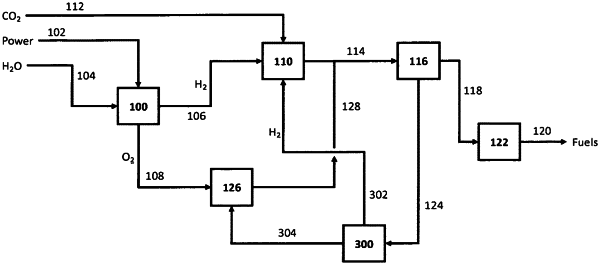| CPC B01J 19/0033 (2013.01) [C01B 3/36 (2013.01); C01B 3/56 (2013.01); C01B 32/40 (2017.08); C10G 2/30 (2013.01); C10L 1/04 (2013.01); C25B 1/04 (2013.01); C25B 15/081 (2021.01); C01B 2203/0244 (2013.01); C01B 2203/0283 (2013.01); C01B 2203/062 (2013.01); C10L 2290/42 (2013.01)] | 19 Claims |

|
1. A method for controlling a process that produces e-fuels, the method comprising:
a. providing a first amount of electrical power to an electrolysis module to produce H2, mixing the H2 with CO2 to provide a gas mixture having a first ratio of H2 to CO2, performing a reverse water gas shift reaction on the gas mixture to produce synthesis gas, and reacting the synthesis gas to produce a liquid hydrocarbon, wherein an auto-thermal reforming module reacts O2 from the electrolysis module with unreacted reactants from reacting synthesis gas to produce a liquid hydrocarbon; and
b. in response to a stimulus, providing a second amount of electrical power to the electrolysis module to produce H2, mixing the H2 with CO2 to provide a gas mixture having a second ratio of H2 to CO2, performing a reverse water gas shift reaction on the gas mixture to produce synthesis gas, and reacting the synthesis gas to produce a liquid hydrocarbon, wherein an auto-thermal reforming, module reacts O2 from the electrolysis module with unreacted reactants from reacting synthesis gas to produce a liquid hydrocarbon,
wherein the second amount of electrical power is an amount between 0 and the amount of electrical power of the first amount, and wherein the second ratio of H2 to CO2 is substantially similar to the first ratio of H2 to CO2.
|